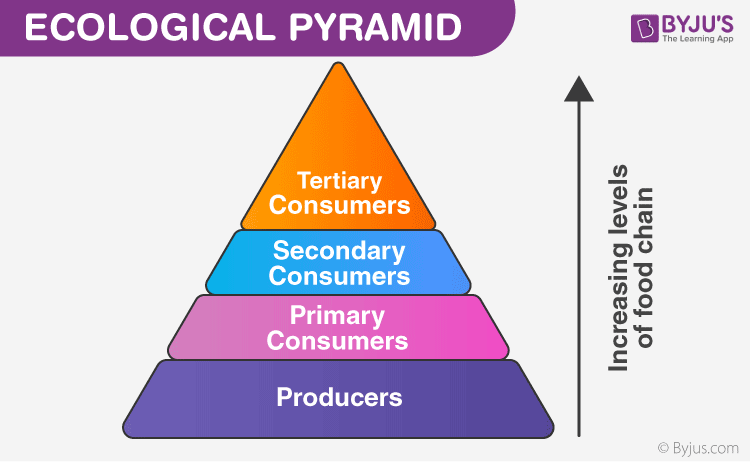Definition
Trophic level is the relative position of an entity in the food chain. It forms the feeding positions in a food web or chain. All food webs and chains have at least two or three trophic levels.
An ecological pyramid depicts how energy and biomass decrease from lower to higher trophic levels.
A diagram illustrating different trophic levels in an ecological pyramid is shown below.

Basic Trophic levels – Examples
|
Trophic level |
Example |
|
Producer – 1st Trophic level |
Plants |
|
Primary consumer – 2nd Trophic level |
Grasshoppers eat grass |
|
Secondary consumer – 3rd Trophic level |
Frogs eat grasshoppers |
|
Tertiary consumer – 4th Trophic level |
Snakes eat frogs |
Several consumers feed at more than one trophic level. For instance, humans are primary consumers when they consume plants. These are secondary consumers when it consumes cows. When they eat fish, they are tertiary consumers.
Trophic Levels and Energy
Energy is transferred up in a food web or chain from lower to higher trophic levels. Typically, only about 10% of the energy at one level is made available to the next level. This representation is shown by the ecological pyramid.
The remaining 90% of the energy is used for metabolic processes or is released into the environment as heat. The energy loss simplifies why there are rarely more than four trophic levels in a food web or food chain. At times there can be a 5th trophic level, however, generally, there is not enough energy remaining to support any extra levels.
Biomass
Biomass is the net mass of organisms at a particular trophic level.
With lesser energy at higher trophic levels, there are typically lesser entities. Organisms tend to be larger in size at a higher trophic level. However, its smaller numbers lead to less biomass.
Ecological Pyramids
The primary trait of each type of ecosystem is trophic structure. In this pyramid, the producer or first level makes up the base of the pyramid. The successive three levels make the apex. The ecological pyramids are of 3 main types, under –
- Pyramid of energy
- Pyramid of biomass
- Pyramid of numbers
Pyramid of energy
This pyramid gives a view of the overall nature of the ecosystem. The weight and number of organisms at any level are based on the rate at which food is being produced. It is upright in shape.
Pyramid of biomass
Comparatively, this pyramid is more fundamentalism. This is because they depict the quantitative relationships of the standing crops instead of the geometric factor. The pyramids may be upright or inverted in shape.
Pyramid of numbers
This pyramid depicts the relationship between herbivores, producers and carnivores at successive trophic levels in terms of their numbers.
In some, the pyramid is upright and in some food chains, the pyramids are inverted (parasites’ food chain).
This was a brief on trophic levels depicted by a diagram. Read related information on trophic levels at BYJU’S.
Also read:
